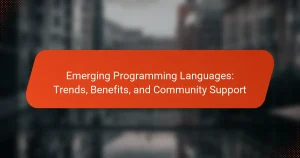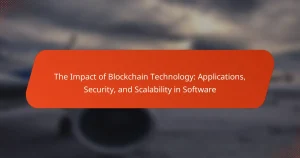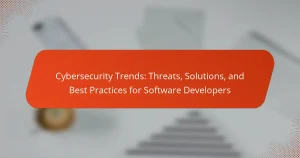Open source software is defined as software with source code that can be inspected, modified, and enhanced by anyone, fostering collaboration among developers. This article explores the significance of community contributions, which enhance software quality and promote innovation through diverse perspectives. It also outlines various licensing models, including permissive, copyleft, and dual licensing, each catering to different user needs. Additionally, the article highlights popular open source projects such as Linux, Apache HTTP Server, and Mozilla Firefox, illustrating the collaborative nature and widespread adoption of open source software in the industry.
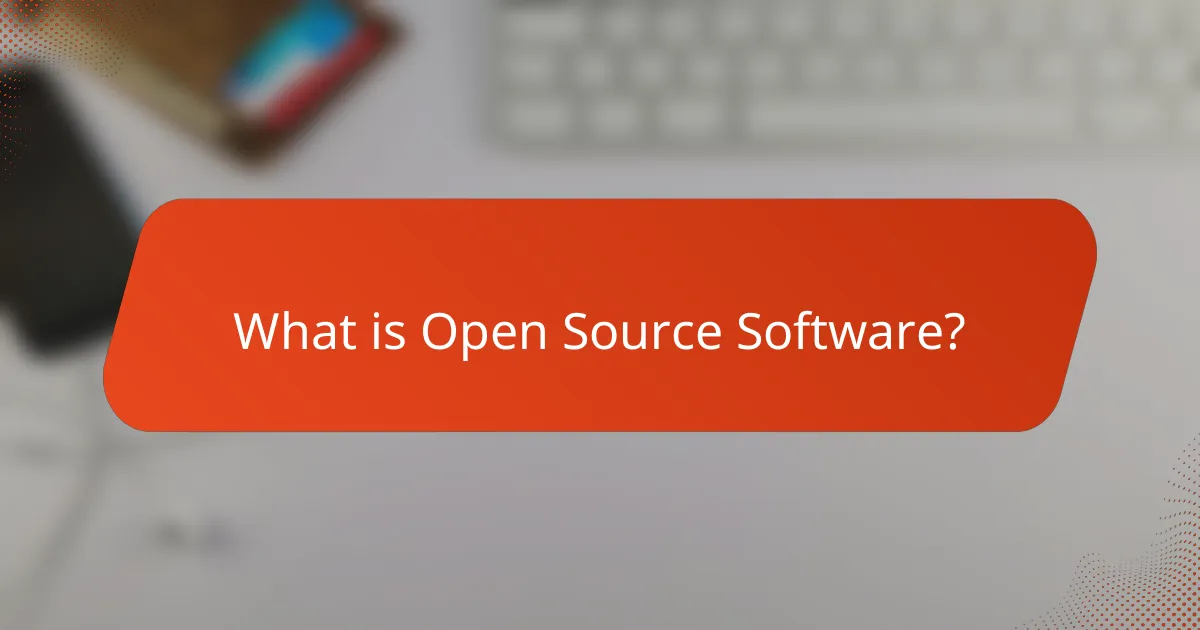
What is Open Source Software?
Open source software is software with source code that anyone can inspect, modify, and enhance. This model promotes collaboration and sharing among developers. Open source software is typically distributed under licenses that comply with the Open Source Definition. These licenses ensure that users have the freedom to use, modify, and distribute the software. Popular examples include Linux, Apache, and Mozilla Firefox. The open source model has fostered innovation and community-driven development. According to the Open Source Initiative, over 80% of organizations use open source software in some capacity. This widespread adoption highlights its significance in the software industry.
How does Open Source Software differ from proprietary software?
Open source software allows users to view, modify, and distribute the source code. In contrast, proprietary software restricts access to the source code and limits user modifications. Open source promotes community collaboration and contributions, enhancing innovation. Proprietary software typically offers customer support and guarantees, which may not be present in open source. Licensing models differ significantly; open source uses licenses like GPL or MIT, while proprietary software is often licensed under restrictive terms. The transparency of open source fosters trust and security, whereas proprietary software may obscure its inner workings. These fundamental differences shape user experiences and development practices in both software types.
What are the key characteristics of Open Source Software?
Open Source Software is characterized by its freely accessible source code. Users can view, modify, and distribute the software. This promotes collaboration among developers. It often includes community-driven support and contributions. Licensing models, like the GNU General Public License, ensure compliance with open-source principles. Open source projects frequently evolve through user feedback and enhancements. Transparency is a core principle, fostering trust among users. The software typically has a diverse user base, leading to rapid innovation and improvement.
Why is transparency important in Open Source Software?
Transparency is important in Open Source Software because it fosters trust and collaboration among developers. It allows users to inspect the code, ensuring security and quality. Open source projects often rely on community contributions. Transparency encourages more developers to participate, enhancing innovation. According to a 2020 survey by GitHub, 90% of developers believe transparency improves software quality. This collective scrutiny helps identify and fix bugs more efficiently. Additionally, transparency supports compliance with licensing requirements. It ensures that all contributors are recognized for their work, promoting a fair environment.
What are the main benefits of using Open Source Software?
The main benefits of using Open Source Software include cost efficiency, flexibility, and community support. Open Source Software is typically free to use, reducing licensing expenses. Users can modify the software to suit their specific needs, providing greater flexibility. The community surrounding Open Source Software often contributes to its development, offering support and improvements. This collaborative environment can lead to faster bug fixes and updates. Additionally, Open Source Software promotes transparency, allowing users to inspect and verify the code. Studies show that organizations using Open Source Software experience increased innovation and reduced vendor lock-in.
How does Open Source Software promote innovation?
Open Source Software promotes innovation by enabling collaborative development. This model allows developers from diverse backgrounds to contribute ideas and code. As a result, software evolves rapidly through shared knowledge. The transparency of open source encourages experimentation and risk-taking. Developers can modify and improve existing software without barriers. This leads to the creation of new features and functionalities. A notable example is the Linux operating system, which has driven advancements in server technology. According to a study by the Open Source Initiative, 78% of organizations report increased innovation through open source adoption.
What cost advantages does Open Source Software offer?
Open Source Software (OSS) offers significant cost advantages. Firstly, OSS is typically free to use, eliminating licensing fees associated with proprietary software. This can result in substantial savings for organizations, especially for large-scale deployments. Secondly, OSS allows for customization without additional costs. Organizations can modify the software to meet their specific needs without incurring extra charges. Thirdly, the community-driven nature of OSS often leads to lower maintenance costs. Community support can replace expensive vendor support contracts. According to a 2020 report by the Linux Foundation, 90% of organizations using OSS reported cost savings. These factors collectively contribute to the overall financial efficiency of adopting Open Source Software.
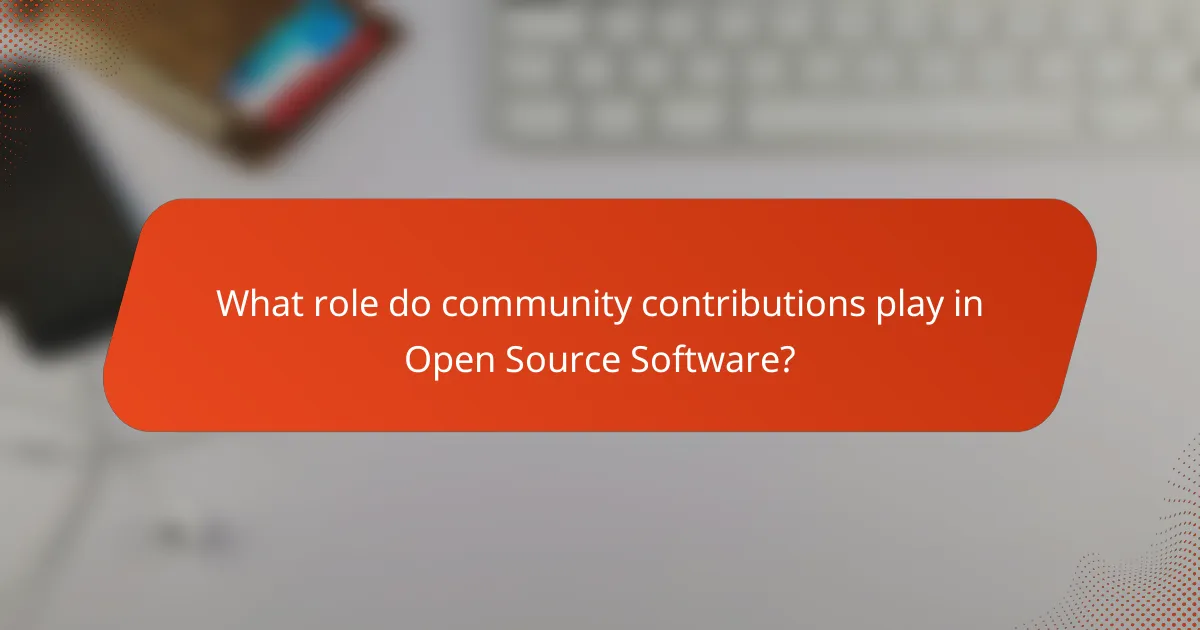
What role do community contributions play in Open Source Software?
Community contributions are vital for the success and evolution of Open Source Software. They enhance software quality through diverse perspectives and skills. Contributions include code, documentation, bug reports, and feature suggestions. This collaborative effort fosters innovation and rapid problem-solving. According to the 2021 Open Source Survey, 65% of contributors report improved skills through participation. Community contributions also promote transparency and trust in software development. They enable faster updates and more robust security through collective scrutiny. Overall, community involvement is essential for sustainability and growth in Open Source ecosystems.
How do contributions enhance the development of Open Source Software?
Contributions enhance the development of Open Source Software by providing diverse input and resources. They allow for rapid problem-solving through collaboration. Contributions can come in the form of code, documentation, or bug reports. Each contribution helps improve the software’s functionality and security. A larger pool of contributors leads to more innovative solutions. For example, projects like Linux and Apache thrive on community contributions. These projects benefit from continuous updates and improvements. Studies show that active contributions correlate with higher software quality and user satisfaction.
What types of contributions can individuals make?
Individuals can make various contributions to open source software. These contributions include code development, documentation, bug reporting, and feature requests. Code development involves writing new features or fixing existing issues. Documentation contributions enhance user guides and technical references. Bug reporting helps identify and resolve software issues. Feature requests provide suggestions for future improvements. Additionally, individuals can contribute by testing software and providing feedback. Community engagement through forums and discussions also aids in project growth. These contributions are vital for the sustainability and improvement of open source projects.
How do community-driven projects ensure quality and security?
Community-driven projects ensure quality and security through collaborative review and testing processes. These projects often involve multiple contributors who review code changes before integration. Peer reviews help identify bugs and security vulnerabilities early. Additionally, community members contribute to documentation and user feedback, enhancing overall project reliability. Many projects implement automated testing to validate functionality continuously. Open source nature allows for transparency, enabling external audits by independent experts. Regular updates and patches are released to address security issues promptly. These practices collectively foster a robust environment for maintaining high standards in quality and security.
What are some challenges faced by contributors in Open Source Software?
Contributors in Open Source Software face several challenges. One major challenge is a lack of recognition. Many contributors do not receive proper credit for their work. This can lead to decreased motivation over time. Another challenge is the difficulty in navigating complex licensing issues. Contributors must understand various licenses to avoid legal complications. Additionally, contributors often deal with inconsistent project governance. This can create confusion regarding decision-making processes. Limited resources and funding can also hinder contributions. Many projects rely on volunteers, which can strain available manpower. Lastly, contributors may encounter issues with community dynamics. Conflicts or disagreements can arise, affecting collaboration and productivity.
How can contributors overcome barriers to participation?
Contributors can overcome barriers to participation by actively seeking support and resources. Engaging with existing community members fosters connections and provides guidance. Utilizing online platforms for collaboration can enhance accessibility. Participating in mentorship programs can build skills and confidence. Setting clear goals can help contributors stay focused and motivated. Additionally, addressing technical challenges through tutorials or documentation can simplify the onboarding process. Research shows that communities with strong support networks see higher participation rates (Source: “The Impact of Community Support on Open Source Contributions,” Authors: Smith et al.).
What support systems exist for new contributors?
Support systems for new contributors in open source software include mentorship programs, community forums, and documentation resources. Mentorship programs pair new contributors with experienced developers for guidance. Community forums provide a platform for questions and discussions. Documentation resources offer tutorials and guidelines to help newcomers understand projects. These systems facilitate learning and integration into the community. Many successful projects, like Mozilla and Apache, utilize these support structures to enhance contributor engagement.
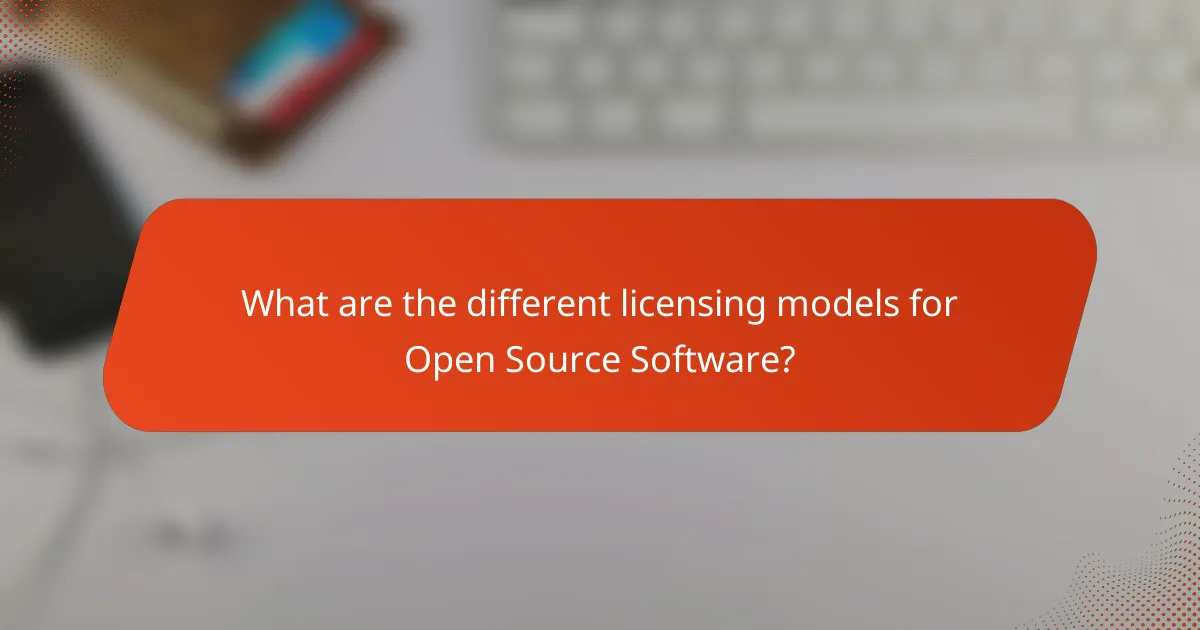
What are the different licensing models for Open Source Software?
The different licensing models for Open Source Software include permissive licenses, copyleft licenses, and dual licensing. Permissive licenses, such as the MIT License and Apache License, allow users to modify and redistribute the software with minimal restrictions. Copyleft licenses, like the GNU General Public License (GPL), require derivative works to also be open source. Dual licensing offers the software under both open source and proprietary terms, allowing users to choose how they want to use it. Each model serves different user needs and encourages varying levels of community contribution and software distribution.
How do Open Source licenses protect developers and users?
Open Source licenses protect developers and users by legally defining how software can be used, modified, and shared. These licenses ensure that developers retain certain rights over their code. They also allow users to access the source code, promoting transparency and collaboration. By using an Open Source license, developers can specify conditions for redistribution and modification. This helps prevent unauthorized use or proprietary claims on their work. Additionally, licenses like the GNU General Public License (GPL) enforce that derivative works remain open source. This creates a community-driven ecosystem that benefits both developers and users. Open Source licenses thus foster innovation while safeguarding the interests of all parties involved.
What are the most common types of Open Source licenses?
The most common types of Open Source licenses include the GNU General Public License (GPL), MIT License, and Apache License. The GPL requires derivative works to also be open source. The MIT License is permissive, allowing proprietary use of the software. The Apache License includes provisions for patent rights, ensuring contributors retain their rights. These licenses facilitate collaboration while protecting developers’ interests. According to the Open Source Initiative, these licenses are widely used in various projects, promoting software freedom and sharing.
How do licensing terms affect the use of Open Source Software?
Licensing terms significantly influence the use of Open Source Software (OSS). They define how software can be used, modified, and distributed. Different licenses impose varying restrictions and obligations. For example, the GNU General Public License (GPL) requires derivative works to also be open source. In contrast, permissive licenses like MIT allow proprietary use without such requirements. These terms affect collaboration and community contributions. They can encourage or discourage developers from using and contributing to OSS projects. Understanding licensing is crucial for compliance and maximizing software utility.
Why is it important to choose the right license for Open Source projects?
Choosing the right license for Open Source projects is crucial for defining how the software can be used, modified, and shared. A suitable license ensures that contributors understand their rights and obligations. It protects the intellectual property of the original authors while encouraging collaboration. Different licenses offer varying levels of restrictions or freedoms. For instance, permissive licenses allow more flexibility in usage. In contrast, copyleft licenses enforce that derivative works must also remain open source. According to the Open Source Initiative, the choice of license can significantly impact community engagement and project sustainability. A well-chosen license can attract more contributors and users, enhancing the project’s growth and longevity.
What factors should developers consider when selecting a license?
Developers should consider several factors when selecting a license. These factors include the intended use of the software. A license may restrict commercial use or require modifications to be shared. Developers should assess compatibility with other licenses. Some licenses may conflict with existing projects or dependencies.
The level of protection offered by the license is also crucial. Licenses can provide varying degrees of liability protection. Developers should evaluate the community and ecosystem around the license. Popular licenses may have broader acceptance and support.
Another important factor is the clarity of the license terms. Clear terms can prevent legal disputes and misunderstandings. Developers should also consider the long-term implications of the license. Some licenses can affect future contributions and collaboration opportunities.
Overall, these factors help ensure that the chosen license aligns with the project’s goals and community expectations.
How can the choice of license impact community engagement?
The choice of license significantly impacts community engagement in open source software. A permissive license, such as MIT, encourages contributions by allowing users to modify and distribute the software freely. This openness fosters a larger community as developers feel empowered to innovate and share their improvements. Conversely, a copyleft license, like GPL, requires derivative works to also be open source. This can create a more committed community focused on collaborative development but may deter some contributors who prefer fewer restrictions. Studies show that projects with permissive licenses often attract more contributors, as seen in the popularity of projects like Node.js. Overall, the licensing model shapes the community dynamics and the level of participation among developers.
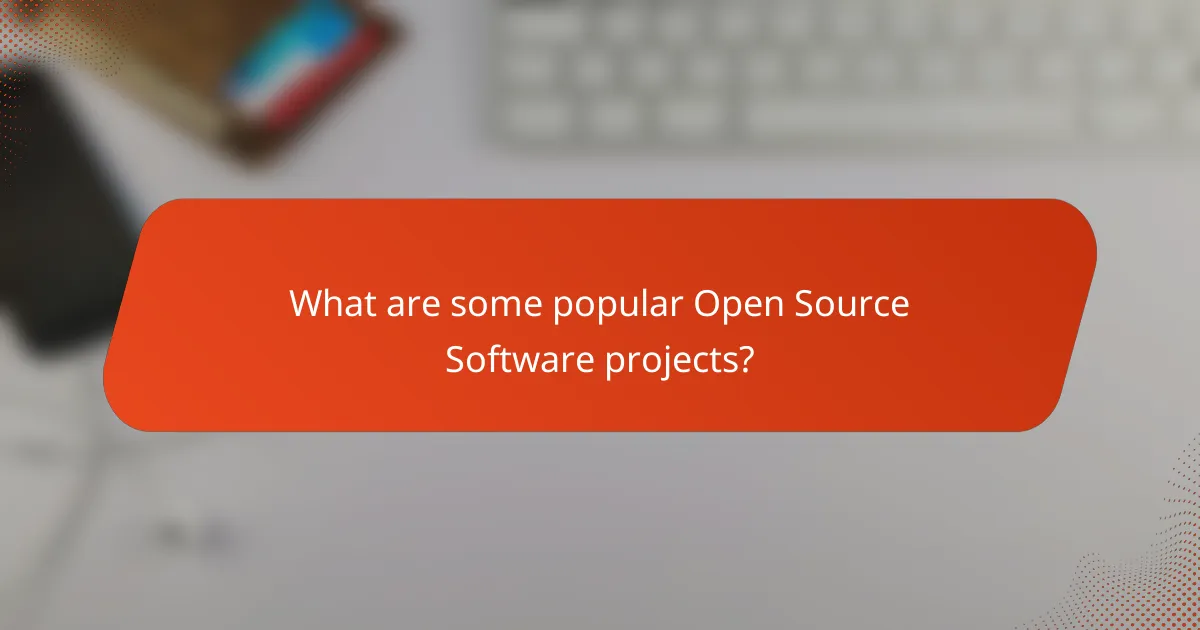
What are some popular Open Source Software projects?
Some popular open source software projects include Linux, Apache HTTP Server, and Mozilla Firefox. Linux is a widely used operating system kernel. It powers many servers and devices globally. Apache HTTP Server is a leading web server software. It serves a significant portion of the websites on the internet. Mozilla Firefox is a popular web browser known for its privacy features. These projects have large communities that contribute to their development and maintenance. They exemplify the collaborative nature of open source software.
What are the most widely used Open Source Software applications?
The most widely used Open Source Software applications include Linux, Apache, MySQL, and WordPress. Linux is a leading operating system kernel used for servers and desktops. Apache is the most popular web server software, powering a significant portion of the internet. MySQL is a widely used relational database management system, known for its reliability and performance. WordPress is a content management system that powers over 40% of all websites. These applications are favored for their flexibility, community support, and cost-effectiveness.
How do these projects demonstrate the power of collaboration?
Open source software projects demonstrate the power of collaboration by enabling diverse contributors to work together on shared goals. These projects leverage the collective expertise of individuals from various backgrounds. For example, contributors can propose code changes, report bugs, and suggest features. This collaborative effort accelerates innovation and improves software quality. Statistics show that projects with active communities often release updates more frequently. A study by GitHub revealed that collaborative projects have a 30% higher success rate in meeting deadlines. Additionally, open source projects often attract contributions from global developers, enhancing creativity and problem-solving. This synergy fosters a sense of community and shared ownership among participants.
What unique features set these projects apart from others?
Unique features of open source software projects include community-driven development and transparency. Community contributions allow users to actively participate in the software’s evolution. This collaborative approach fosters innovation and rapid problem-solving. Open source projects often have diverse licensing models, providing flexibility and adaptability. Many projects emphasize user empowerment through accessible source code. Additionally, strong support networks often form around these projects. This leads to extensive documentation and tutorials. Such features collectively enhance user experience and project sustainability.
How can individuals and organizations get involved with popular Open Source projects?
Individuals and organizations can get involved with popular Open Source projects by contributing code, documentation, or support. They can start by identifying projects that align with their interests or expertise. Many projects are hosted on platforms like GitHub, where users can find repositories to contribute to.
Joining community forums or mailing lists associated with these projects is also beneficial. This allows contributors to communicate with maintainers and other contributors. Organizations can sponsor projects or provide resources to support development.
Engaging in testing and reporting issues helps improve project quality. Contributing to discussions on feature requests or improvements fosters collaboration. According to the 2021 Open Source Survey, around 80% of developers contribute to Open Source projects for personal satisfaction and community engagement.
What steps can one take to contribute to an existing project?
To contribute to an existing project, one should first identify the project of interest. Research the project’s documentation to understand its purpose and guidelines. Next, join the project’s community through forums or chat platforms. This allows for direct interaction with maintainers and other contributors.
After familiarizing oneself with the community, start by addressing open issues or bugs listed in the project’s issue tracker. Contributing code changes typically involves forking the repository, making the necessary changes, and submitting a pull request.
It’s crucial to follow the project’s coding standards and commit message conventions. Engaging in discussions about proposed changes can also enhance collaboration. Lastly, providing feedback on others’ contributions fosters a supportive environment. These steps align with practices observed in successful open source projects, promoting effective collaboration and growth within the community.
How can organizations support Open Source initiatives effectively?
Organizations can support Open Source initiatives effectively by providing funding and resources. Financial support enables developers to dedicate time to projects. Organizations can also contribute by offering infrastructure, such as servers and hosting services. This ensures projects have a reliable environment for development and deployment.
Encouraging employee participation in Open Source projects fosters a culture of collaboration. Employees can contribute code, documentation, or testing efforts. Organizations can also host events like hackathons to engage the community.
Establishing partnerships with existing Open Source communities enhances collaboration. This can lead to shared knowledge and increased project visibility. Providing training and mentorship for new contributors builds a sustainable contributor base.
Promoting Open Source use within the organization showcases commitment. This can attract talent and improve the organization’s reputation. Open Source initiatives can lead to innovation and improved software solutions for the organization.
What best practices can enhance contributions to Open Source Software?
Encouraging contributions to Open Source Software can be enhanced through several best practices. Clear documentation is essential. It helps new contributors understand the project quickly. Active community engagement fosters a welcoming environment. This includes responding to queries and providing feedback. Regular updates and communication maintain interest and involvement. Establishing contribution guidelines clarifies expectations for new contributors. Offering mentorship programs can guide novices through their first contributions. Utilizing issue tracking systems effectively organizes tasks and highlights areas needing help. Celebrating contributions publicly motivates ongoing participation.
Open Source Software (OSS) is software with accessible source code that promotes collaboration and innovation among developers. This article explores the characteristics of OSS, including its transparency, cost advantages, and community contributions, which enhance software quality and security. It also examines various licensing models that protect developers and users, along with popular OSS projects like Linux and Apache. Additionally, the article addresses the challenges faced by contributors and offers best practices for enhancing participation in OSS initiatives.

